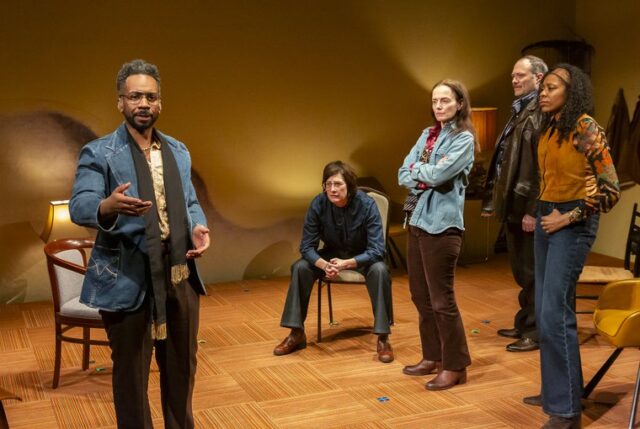
Five actors re-create 1970s WNYC programs in documentary play (photo by Hunter Canning)
RADIO DOWNTOWN: RADICAL ’70s ARTISTS LIVE ON AIR
59E59 Theaters
59 East 59th St. between Park & Madison Aves.
Tuesday – Sunday through February 9, $44
212-279-4200
www.59e59.org
The Civilians’ Radio Downtown: Radical ’70s Artists Live on Air is an odd documentary play that is difficult to decipher. Conceived and directed by Steve Cosson and written by Cosson and Jocelyn Clarke, it consists of five actors re-creating segments from three 1970s programs on WNYC: Arts Forum, Artists in the City, and Poetry of the Avant-Garde.
The conceit is that, as the audience is told at the start, “The actors do not know their lines. This is made from archival recordings. The actual words, pauses, and sounds from back then will be fed into the actor’s ears.” I’m not quite sure why Cosson decided to present the dialogue that way; it makes for an uneasy experience, as I found myself on edge every time an actor paused, wondering whether the hesitation was in the original interview, there was a technical glitch, or the performer lost their place. In addition, these are professional actors, and one would think that, especially after several weeks of performance, they would know their lines, complete with pauses and hesitations.
Robert M. Johanson, Jennifer Morris, Joshua David Robinson, Maya Sharpe, and Colleen Werthmann portray a who’s who of the avant-garde scene: film theorist and historian P. Adams Sitney, experimental choreographer, dancer, and visual artist Yvonne Rainer, filmmakers George Kuchar and Kenneth Anger, poets Leroi Jones and Lorenzo Thomas, critic and academic Annette Michelson, polymath Harry Smith, and actress, dancer, and singer Kimako Baraka, among others. The seventy-minute production takes place in a room with numerous chairs, lamps on the floor (did they run out of tables, or was this how it was at WNYC?), and a back wall featuring a large image of part of a naked human body with a fly on its mouth.
The actors switch between characters by making small clothing adjustments, selecting jackets, vests, and other apparel hanging from hooks on each side of Andrew Boyce’s set. (The costumes are by Emily Rebholz.) Attilio Rigotti’s projections identify the speakers and include newspaper headlines, snippets from a Rainer dance rehearsal, and clips from Anger’s 1967 Lucifer Rising, which starred Bobby Beausoleil, who committed murder the next year as an associate of the Manson family and is still serving life in prison.
The highlight of the show is Anger discussing fellow filmmaker Maya Deren’s apparent disgust of his work. Deren had sent a letter to Anger explaining why she chose not to award a film of his a prize at a festival; in response, Anger describes, “I wrote her back and I said, ‘The whole thing was a joke.’ And she wrote me back and said, uh, she said, ‘You are guilty of confounding the public, and you are also guilty of pulling my leg, [laughter] and I will never forgive you.’ And I said, well, if she has — if she has such a lack of a sense of humor. . . .”
As far as a sense of humor goes, I was questioning mine throughout Radio Downtown, particularly when Werthmann, as Rainer, mimicked some of the choreographer’s slow, angular movement. While my theater companion found it hilarious in a good way, I was perplexed, uncertain whether it was a pretentious tribute or a playful parody of Rainer and the whole underground scene.
That was essentially my takeaway from the show, a constant level of confusion. Later, I checked out The NYPR Archive Collections, where you can listen to the original recordings and read the transcripts.
When I heard Rainer talk to Michelson about “kinesthetic empathy,” I knew just what she meant.
[Mark Rifkin is a Brooklyn-born, Manhattan-based writer and editor; you can follow him on Substack here.]